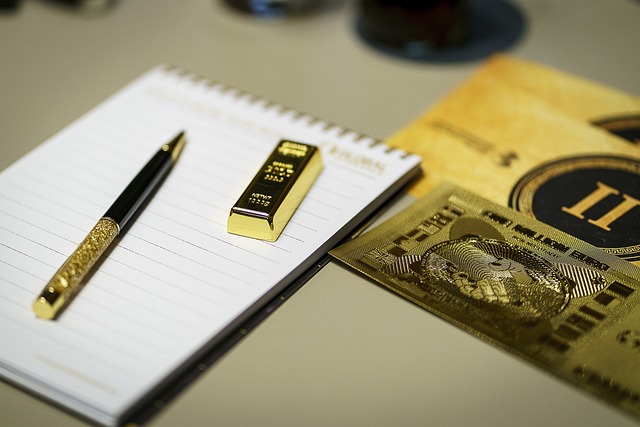To invest in gold through a Roth IRA, one must first establish a self-directed Roth IRA with a custodian experienced in managing precious metals investments compliant with IRS standards. Investors then transfer funds into this account and purchase IRS-approved gold coins or bars from specialized dealers. Storage and reporting of these investments must be handled through an IRS-approved custodian or depository to maintain tax benefits and adhere to regulatory requirements. The process involves careful selection of both a custodian and dealer, ensuring compliance with IRS Publication 590 regarding gold purity and categories. This approach allows for diversification within a retirement portfolio while navigating the complexities of investing in precious metals under the Roth IRA framework.
Exploring the transformation of a Roth IRA into a golden retirement nest egg, our article demystifies the process. It begins with setting up a self-directed Roth IRA tailored for precious metals like gold, offering a unique investment avenue beyond the conventional stock and bond markets. Subsequent steps ensure compliance with IRS regulations, guidance on selecting a specialized trustee, funding strategies, and securing approved storage solutions for your physical gold. This journey into alternative retirement investments aims to empower you with knowledge and confidence in diversifying your portfolio with the enduring value of gold.
- Establishing a Self-Directed Roth IRA for Precious Metals Investment
- Compliance with IRS Regulations for Roth IRA Conversion
- Selecting a Trustee Specializing in Gold Investments
- Funding the Self-Directed Roth IRA with Cash or Assets
- Purchasing Physical Gold and IRS Approved Storage Solutions
Establishing a Self-Directed Roth IRA for Precious Metals Investment

To initiate the process of converting your Roth IRA to an investment in gold and other precious metals, the first step is to set up a self-directed Roth IRA. This specialized account diverges from traditional IRAs by offering investors the autonomy to allocate funds into alternative assets such as physical gold, silver, platinum, and palladium coins or bars that meet specific Internal Revenue Service (IRS) standards. Establishing this type of IRA involves selecting a custodian that specializes in self-directed accounts and is equipped to handle non-traditional investments like precious metals. These custodians are well-versed in the rules and regulations governing such investments, ensuring compliance with IRS guidelines. Once you’ve chosen a reputable custodian, you can proceed with transferring funds from your existing Roth IRA into the new self-directed account, after which you may begin the process of purchasing the physical gold or other precious metals that align with your investment strategy and diversification goals. It’s crucial to conduct thorough due diligence on both the custodian and the precious metals dealers to ensure transparency, competitive pricing, and secure storage options for your investments. Additionally, investors should be aware of the various forms of precious metals acceptable within a self-directed Roth IRA, as well as the requirements for storage and reporting to maintain the tax advantages associated with this investment vehicle.
Compliance with IRS Regulations for Roth IRA Conversion

When considering the conversion of a Roth IRA to gold, adherence to Internal Revenue Service (IRS) regulations is paramount. The IRS stipulates that any conversion from a traditional IRA to a Roth IRA must be done in accordance with specific rules and guidelines. These include limitations on the amount one can convert based on income levels and modified adjusted gross income (MAGI). Additionally, the funds converted must be reported as non-deductible IRAs on your tax return for the year of the conversion.
Once you have initiated the conversion process, it is equally important to ensure that the self-directed Roth IRA is set up with a trustee or custodian that specializes in alternative assets, such as physical gold and other precious metals. The IRS has strict requirements for what constitutes eligible precious metals for IRA investment purposes. These typically include gold, silver, platinum, and palladium in specific forms and purities. The trustee or custodian will facilitate the transaction and ensure that the purchase of the gold adheres to these standards. It is imperative to work closely with both a trusted financial advisor and an IRS-approved custodian throughout this process to guarantee compliance and to navigate the tax implications associated with the conversion effectively.
Selecting a Trustee Specializing in Gold Investments

When considering the conversion of your Roth IRA to gold, it is crucial to select a trustee with expertise in gold investments. This specialist will guide you through the process of purchasing and holding physical gold or gold-backed assets within your retirement account. The trustee’s role is pivotal; they must be well-versed in the regulations governing retirement accounts as well as the nuances of the precious metals market. Their knowledge ensures compliance with IRS standards for eligible IRA investments, which include certain types of gold, silver, platinum, and palladium.
To commence this financial strategy, you must identify a trustee who offers self-directed Roth IRAs with a focus on gold. This trustee will facilitate the account setup and assist in locating a reputable precious metals dealer for the acquisition of your gold assets. The dealer should be approved by the IRS and provide investments that meet the purity and type requirements for IRA holdings. By partnering with a trustee who specializes in gold investments, you can navigate the complexities of this alternative investment strategy with confidence, secure in the knowledge that your financial future is backed by a tangible asset.
Funding the Self-Directed Roth IRA with Cash or Assets

To initiate the process of converting a Roth IRA to gold, one must first set up a self-directed Roth IRA that accommodates investments in physical gold and other precious metals. This self-directed account differs from traditional IRAs as it offers investors the advantage of diversifying their portfolio beyond the conventional stocks and bonds. Once you have established this specialized account with a trustee or custodian that allows for such investments, you can proceed to fund it. Funding options are versatile; you may choose to contribute cash directly into the account, taking advantage of annual contribution limits set by law. Alternatively, if you have existing assets, such as stocks, bonds, or other investment vehicles, you can transfer them into your new Roth IRA. This transfer is typically done through a process known as an in-kind distribution from your current IRA, 401(k), or another eligible retirement plan. It’s important to coordinate with both the old and new account custodians to ensure a smooth transfer, adhering to IRS regulations and avoiding any unnecessary taxes or penalties. Once the transfer is complete, you will have successfully funded your self-directed Roth IRA with either cash contributions or by rolling over assets, setting the stage for investing in gold and other precious metals.
Purchasing Physical Gold and IRS Approved Storage Solutions

When considering the conversion of a Roth IRA to physical gold, it’s crucial to focus on acquiring gold coins or bars that are approved by the Internal Revenue Service (IRS). The IRS stipulates that for gold to be held in an IRA, it must meet certain fineness requirements and fall under specific categories as defined in the IRS Publication 590. Investors must purchase these commodities from IRS-approved dealers to maintain the tax-advantaged status of their Roth IRA.
Once the appropriate physical gold is acquired, securing an IRS-approved storage solution is the next step. The IRS requires that the physical gold within a self-directed Roth IRA be stored with a custodian or depository that complies with IRS rules. These custodians or depositories provide secure, insured environments, ensuring the safety and integrity of the investment. They also facilitate compliance with reporting and audit requirements. Investors have the option to choose between third-party custodians or specialized gold IRA depositories, each offering different services and levels of involvement in managing the assets within the IRA. It’s important to conduct thorough research and select a reputable custodian or depository to store your gold, as this will safeguard your investment and maintain the tax benefits associated with your Roth IRA.
In conclusion, transitioning a Roth IRA into an investment in gold is a process that combines financial strategy with a clear understanding of IRS regulations. By setting up a self-directed Roth IRA geared towards precious metals, investors gain the advantage of diversifying their retirement portfolio beyond conventional stocks and bonds to include tangible assets like gold. Ensuring compliance with tax laws and selecting a trustee who specializes in such investments are critical steps. Once established, funding the account with either cash or other assets sets the stage for purchasing physical gold, which can be stored securely in IRS-approved solutions. This strategic move not only provides a hedge against inflation but also offers a potentially robust investment option within a retirement framework.
